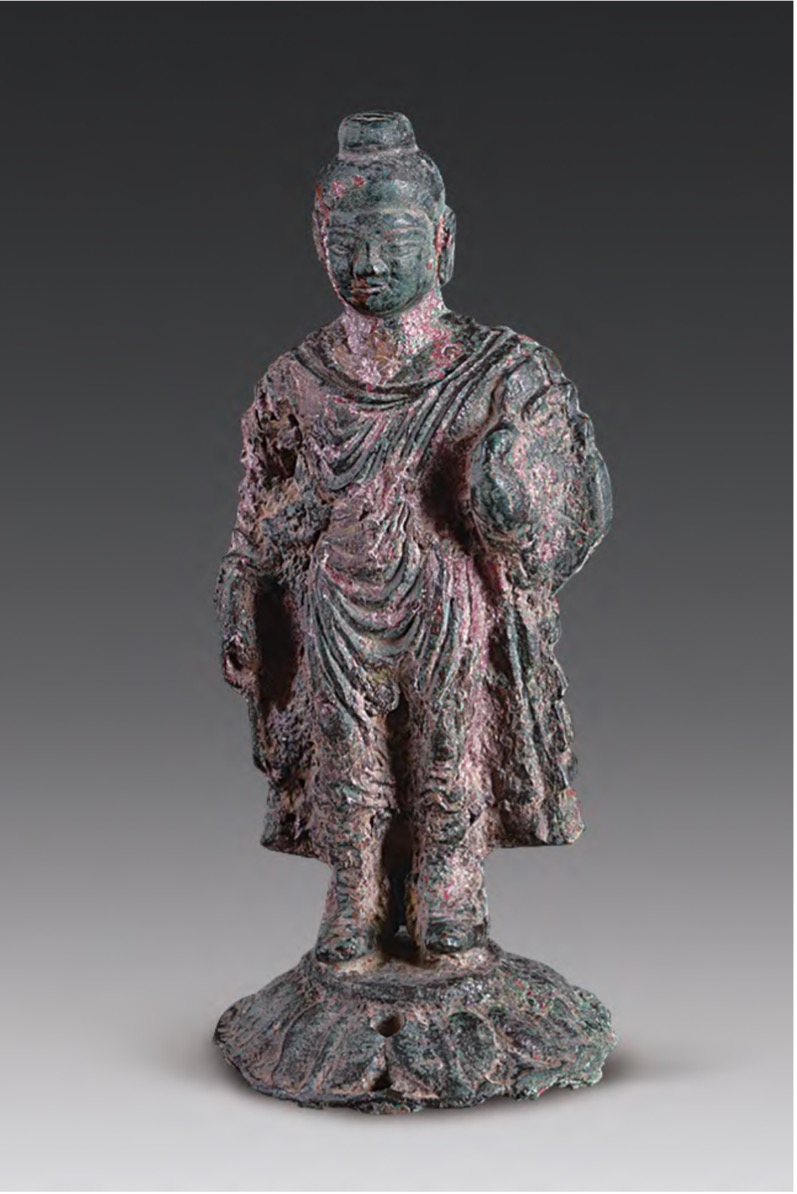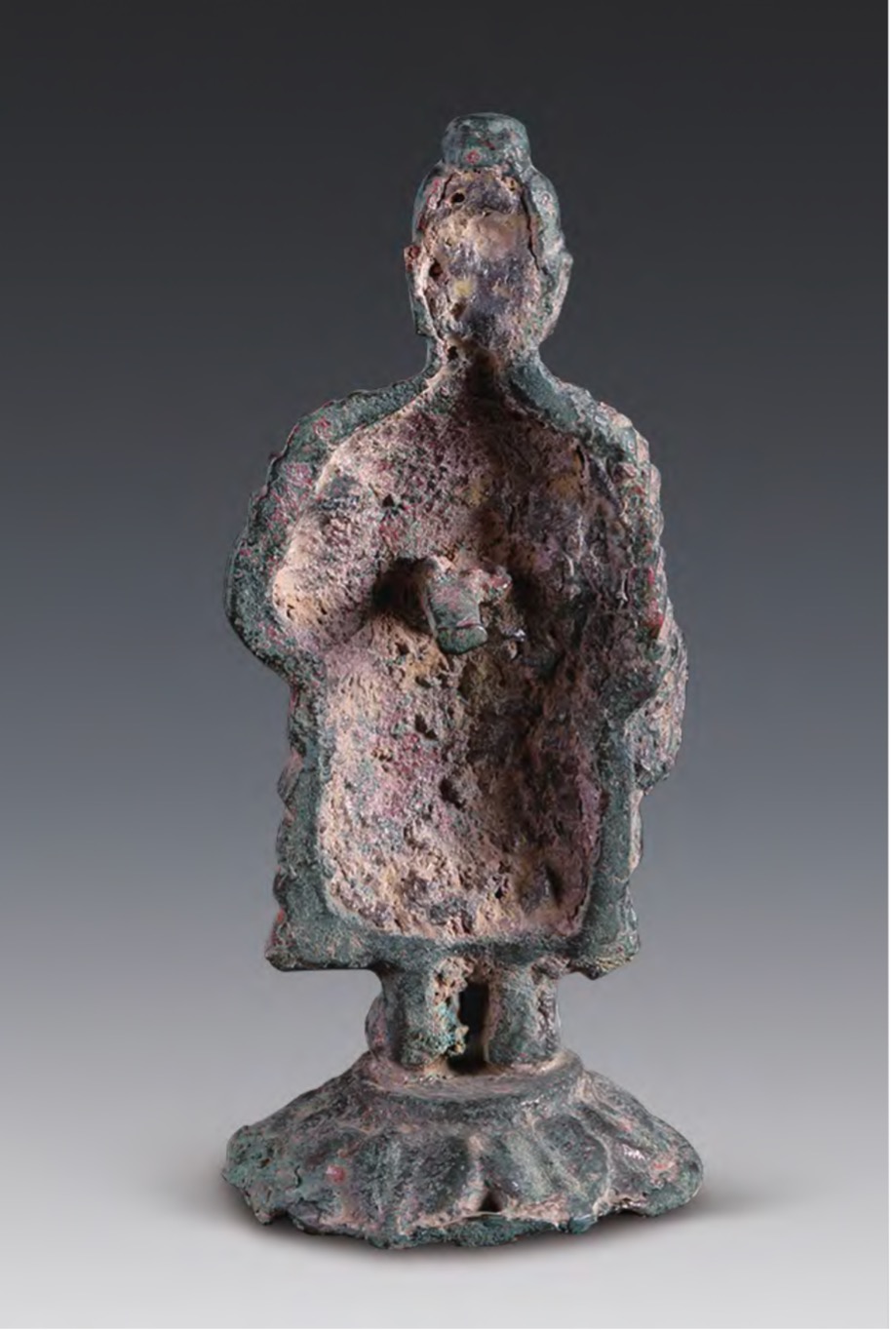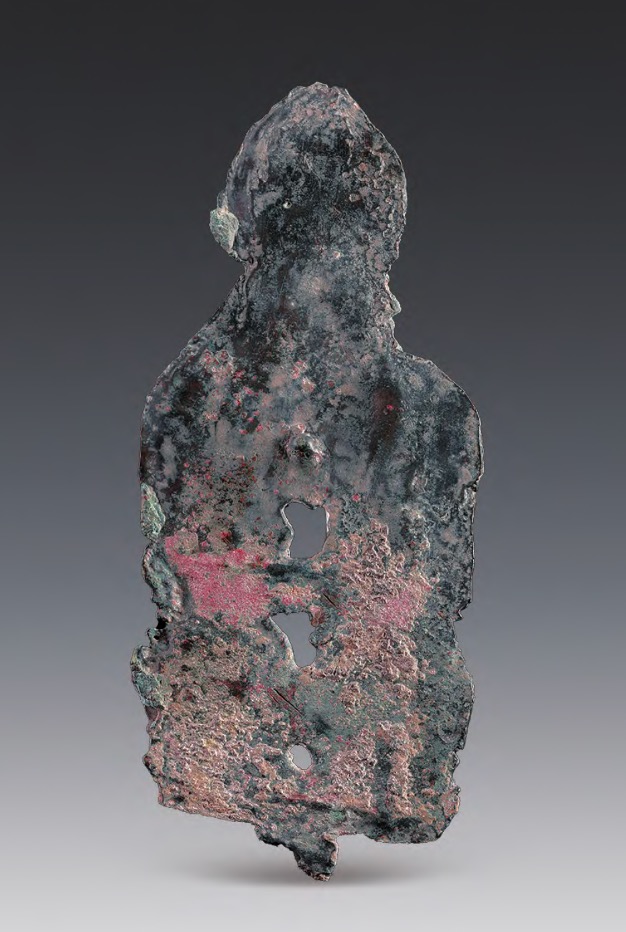Gold Gilded Bronze Buddha Statues Discovered in Xianyang Chengren Tombs
In 2021, two gold gilded bronze Buddha statues were discovered in a tomb located in the southeast of Chengren village of Xianyang city in Shaanxi Province. 1 The discovery of the statues soon attracted the attention of several scholars, because some claimed the statues belong to the earliest gold gilded bronze Buddha statues, dating all the way back to the Eastern Han dynasty (25-220 CE). Other scholars, however, argue the statues are dated to the period of the Sixteen States (AD 304-439; also known as the Sixteen Kingdoms). According to them, the statues’ style and material better match this period from which most gold gilded bronze Buddha statues are dated.
The tombs are preserved with an aligning pattern, which suggests that the tomb occupants belonged to the same family. Among the two gold gilded bronze Buddha statues discovered in tomb M3015, one is a standing Buddha cast with a single piece of mold [Fig. 1]. It is 10.5 cm in height and the diameter of its bottom base measures 4.7 cm. The statue has an open hollow back, in the middle of which protrudes a short joint, which is suspected to be connected with the halo of the statue [Fig. 2]. 2 The standing Buddha has a plain ushnisha (oval shape on top of the head of the Buddha). Its facial features are rendered coarsely. The Buddha wears a body-length robe, whose pleats are represented by U-shape patterns. The left hand of the Buddha holds a corner of the folded robe, and the right hand of the Buddha is missing. The excavation report says that the right hand is in the mudra of fearlessness. 3 The Buddha stands on a base in the shape of a lotus flower. The base was made separately from the standing Buddha. They are joined together through the protruding joint at the bottom of the statue.
The other statue is a piece of single-mold-cast artifact with five Buddha statues in the front [Figs. 3-4]. It measures 15.8 cm in height and 6.4 cm in width. Its bottom has a protruding joint, which suggests that it might have been plugged into a base. 4 The piece is slightly damaged, causing three little holes in the middle. The front of the statue depicts five Buddhas in relief. On each side of the shoulders of the Buddha, which is located on the very top, is a small hole, through which the statue might have been attached to a niche. 5 The five Buddha statues in the front share similar features. They all have a plain ushnisha on top of their heads and sit cross-legged on the lotus seat with a meditation mudra.

Fig. 1: Frontal view of the standing Buddha from Chengren tomb M3015, anonymous, gold gilded bronze, 10.7×4.5cm, disputed date between Eastern Han (25-220CE) and the Sixteen States period (AD 304-439), Shaanxi. Source: Shaanxisheng kaogu yanjiuyuan, “Shaanxi xianyang chengren mudi donghan jiazumu fajue jianbao, Kaogu yu wenwu 2022 (1): Cover 2.

Fig. 2: Back view of the standing Buddha from Chengren tomb M3015, anonymous, gold gilded bronze, 10.7×4.5cm, disputed date between Eastern Han (25-220CE) and the Sixteen States period (AD 304-439), Shaanxi. Source: Shaanxisheng kaogu yanjiuyuan, “Shaanxi xianyang chengren mudi donghan jiazumu fajue jianbao, Kaogu yu wenwu 2022 (1): Cover 2.
The gold gilded bronze Buddha statues from Chengren tomb M3015 are considered to be the earliest of their kind in the archaeological report. 6 The claim would have been beyond doubt if the tomb had not been robbed. At the western end of the tomb’s path, there is an early robbing hole. The hole is 3.4 meters away from where the Buddha statues were discovered. The distance between the robbing hole and the placement of the Buddha statues is considered far enough to assert that the Buddha statues were not brought in later by tomb robbers. In addition, there is little motivation for the tomb robbers to bring the Buddha statues and leave them in the tomb. 7 As a result, the author of the archaeological report regards the gold gilded bronze Buddha statues as funeral objects of the tomb M3015, and they were made no later than late Han dynasty. Scholars who hold the same opinion are Ran Wanli, Li Ming, and Zhao Zhanrui. In their article, they argue that the purpose of tomb robbers is to take objects instead of bringing the Buddha statues into the tomb. 8

Fig. 3:Frontal view of five seated Buddhas from Chengren tomb M3015, anonymous, gold gilded bronze, 15.8×6.4cm, disputed date between Eastern Han (25-220CE) and the Sixteen States period (AD 304-439), Shaanxi. Source: Shaanxisheng kaogu yanjiuyuan, “Shaanxi xianyang chengren mudi donghan jiazumu fajue jianbao, Kaogu yu wenwu 2022 (1): Cover 2.

Fig. 4:Back view of five seated Buddhas from Chengren tomb M3015, anonymous, gold gilded bronze, 15.8×6.4cm, disputed date between Eastern Han (25-220CE) and the Sixteen States period (AD 304-439), Shaanxi. Source: Shaanxisheng kaogu yanjiuyuan, “Shaanxi xianyang chengren mudi donghan jiazumu fajue jianbao, Kaogu yu wenwu 2022 (1): Cover 2.
Yao Chongxin argues that it is possible the gold gilded bronze Buddha statues were brought into the tomb later by tomb robbers and that the statues are dated to the Sixteen States period. 9 The surface of both of the statues is worn and shiny, which suggests that they were often carried by their owners. Yao proposes that it is possible that the statues were belongings of the tomb robbers that were left accidentally in the tomb. The statues, which could be carried, may have functioned as amulets of the tomb robbers. More importantly, the style and material of the statues resemble those dated to the period of the Sixteen States. The standing Buddha statue discovered in Chengren is highly similar to a standing Buddha statue held in a private collection in Japan and another statue held in Kyoto National Museum, both of which are dated to the Sixteen States period. Most of the gold gilded bronze Buddha statues from the Sixteen States period are made of bronze, tin, and lead, which is also the main composition of the statues from the Chengren tomb. 10 Chengren tomb M3015 is not the only Eastern Han tomb where bronze Buddha statues were left by later tomb robbers from the Sixteen States period. A seated bronze Buddha statue and a seated gold gilded bronze Buddha statue were discovered in a late Eastern Han tomb in Shijiazhuang, Hebei. 11
CHEN Ying is a lecturer in the Department of Art History at Shanghai University. Email: yingchen_ox@163.com